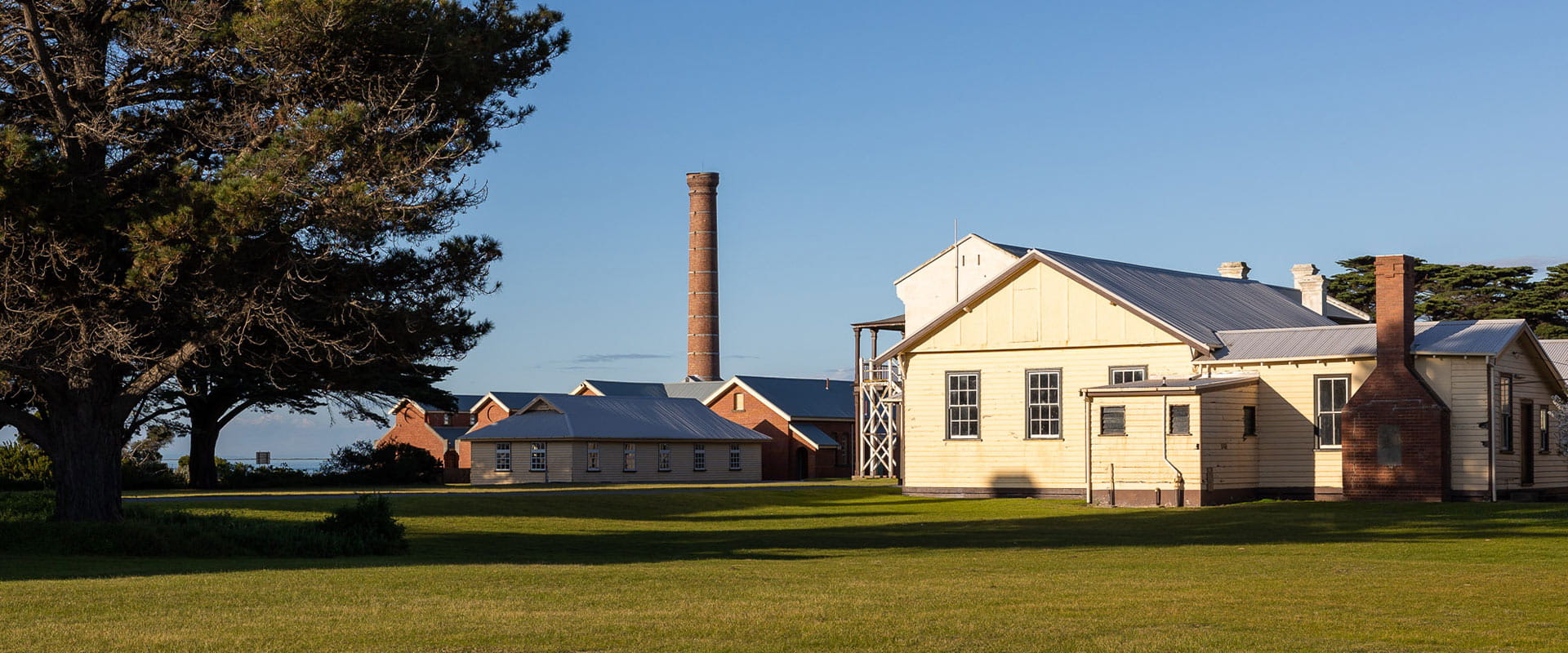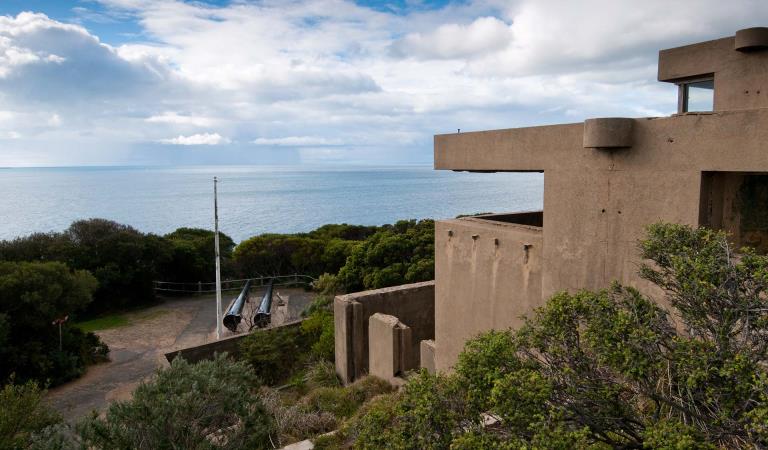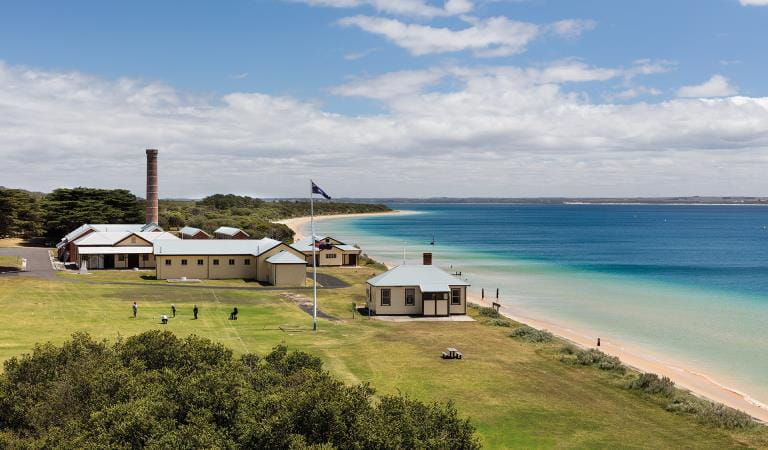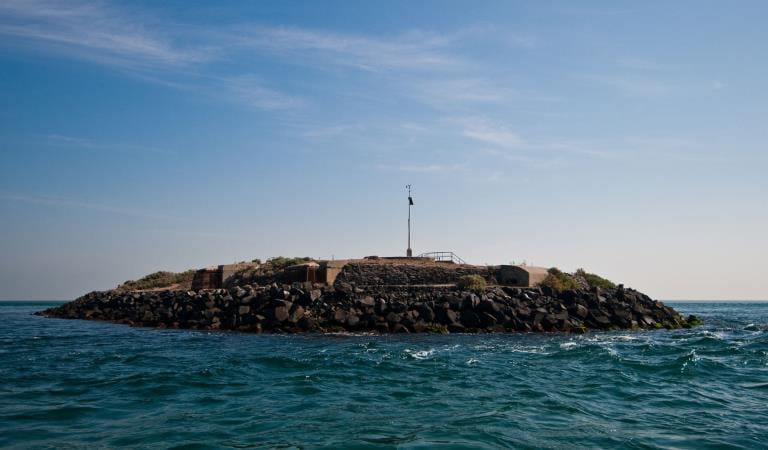There's so much to see and do at Point Nepean National Park. A walk from the Quarantine Station to Fort Nepean, along Coles Track with stops at Observatory Point and Gunners Cottage, will uncover many of the historical highlights of this unique place.
Get off the beaten track by taking the 1.8km Range Area Walk which meanders through coastal scrub, a former Rifle Range and passes Monash Break and Light. The walk links to the Quarantine Station and Cheviot Hill. This area was used for military training by the Army from 1952 when they came to Point Nepean as the Officer Cadet School. Referred to as the Defence Reserve, many forms of training took place which included mostly firing of live arms, infantry weapons, utilising rockets and rifles. Parks Victoria and the Department of Defence completed a program to progressively clear much of this area which has allowed for the opening of the Range Area Walk. Visitors can take the stairs to a viewing platform halfway up the Monash Light tower and take in the sweeping views of the national park, the bay and ocean, and city skyline.
Point Nepean is also the site where former Australian Prime Minister Harold Holt disappeared while swimming at Cheviot Beach without a trace in December 1967. Just 500m west of Cheviot Hill, deviate 30m off Defence Road to arrive at viewing platform overlooking Cheviot Beach. A memorial granite plinth on the approach to the viewing platform honours the legacy of this tragedy. Access to Cheviot Beach is not permitted for safety and conservation reasons.
Things to do in the area
Point Nepean is the traditional Country of the Bunurong People who have lived on and around this important cultural place for over 35,000 years. The coastline has been an important source of shellfish and other foods and extensive shell middens are reminders of the enduring association that Traditional Owners have with this area.
European arrival
Point Nepean has evidence of some of the earliest European settlement in Victoria, including pastoral activities and lime burning. Shepherd’s Hut, located in the Quarantine Station, is one of the earliest intact limestone buildings in Victoria. Its cellar dates to 1845.
Quarantine
Established in 1852, the Quarantine Station was the major place for quarantine purposes in Victoria until 1979 and was closed in 1980. Animals were also quarantined here and you can see the remains of the jetty built for this purpose in 1878 at nearby Observatory Point. The beach here is a beautiful spot for a picnic.
The walk to Observatory Point is 2km / 30 minute along Coles Track from the Quarantine Station. While you're there, take the Walter Pisterman Walk inland to nearby Gunners Cottage and Point Nepean Cemetery, where those who died in quarantine are buried. If you're on a bicycle you can continue along Coles Track to Gunners Cottage.
Defence
The entrance to Port Phillip was once the most heavily fortified port in the Southern Hemisphere. There are many Colonial and Commonwealth structures from the 1880s–1940s located around the park. Fort Nepean is considered to be one of the best examples in Australia of a major fort complex exhibiting the changes in military engineering over the 19th and 20th centuries.
The walk from Gunners Cottage to Fort Nepean is approximately 3km or 45 minutes. On the way, you can explore the remains of Fort Pearce, Pearce Barracks and Eagles Nest. Fort Pearce was established in 1911 and designed to take advantage of the six-inch Mark VII guns being introduced to coastal defence at that time. The Pearce Barracks site is where many of the army personnel stationed at Point Nepean lived. Eagles Nest was the site of Australia’s largest 'Disappearing Gun'.
National Park
After World War II, soldiers were removed from the forts and the buildings and fortifications declared redundant. The area remained closed to the public and was used as an occasional firing range and training ground until 1988 when, as part of the Bicentennial celebrations, control of the site was transferred to Victoria, declared a national park and opened to the public. The Quarantine Station became part of the national park in 2009.
Fort Nepean
Quarantine Station
South Channel Fort
How to get there
Point Nepean Historic Highlights
When you're there
All of the historic highlights are within a comfortable walking or cycling distance of each other. There are picnic benches at most of the highlights listed, but Observatory Point by the beach and the Parade Ground at the Quarantine Station are particularly good spots.
The information centre at the Quarantine Station has all the information you need to plan your day trip. You can talk to our friendly staff for local advice on exploring the park.
Walk
The walk to Fort Nepean from the Quarantine Station carpark is approximately 4.5km and takes an hour and fifteen minutes one way. The walk from Gunners Cottage carpark is a little shorter. The walk from the front entrance gate is approximately 5.5km and a longer walk of around an hour and forty-five minutes one way.
Cycling
Cycling is a great way to explore the many historic sights at Point Nepean National Park. Visitors can bring their own bikes or hire them (including e-bikes) from the Quarantine Station Visitor Information Area. Cycling is permitted in the Quarantine Station Area, along Defence Road to Fort Nepean and along Coles Track which is a shared path with walkers. Helmets must be worn and a lock is recommended when leaving your bike.
Shuttle bus
Alternatively, the Point Nepean shuttle service runs between the Quarantine Station and Fort Nepean.
Need to know
Point Nepean Historic Highlights
Change of Conditions
Nature being nature, sometimes conditions can change at short notice. It’s a good idea to check this page ahead of your visit for any updates.
-
Fort Nepean (Point Nepean National Park)
Access restricted to tracks and gun emplacements
The Engine House Walk, the circuit track at Fort Nepean, has been impacted by erosion and a section is closed for safety reasons. The outside of the Engine House can still be visited by steps.
Entry to Gun emplacements #5 and #6 is restricted at this time, however they can be viewed from behind safety barriers. We will be undertaking some works, which will hopefully allow these to be fully accessible to visitors in the future.





